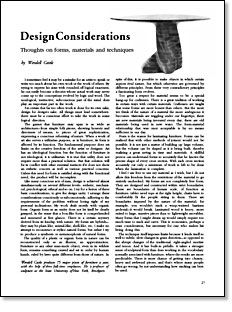Design Considerations
Thoughts on forms, materials and techniques
Synopsis: When a work of art also serves a utilitarian purpose, as does furniture, its form is affected by its function, writes sculptor and furniture maker Wendell Castle. To give a design unity, he strives to fuse aesthetic, mechanical, psychological, ethical, and other levels in each piece. He deals mostly with organic forms, trying to produce a synthesis or metamorphosis of natural forms. He shares his ideas on these issues, on the relationship woodworkers have with their material, and on how he laminates, to realize certain forms or to build up volume as he goes.
I sometimes feel it may be a mistake for an artist to speak or write too much about his own work or the work of others. By trying to express his aims with rounded-off logical exactness, he can easily become a theorist whose actual work may never come up to the conceptions evolved by logic and word. The nonlogical, instinctive, subconscious part of the mind does play an important part in the work.
I’m certain that far too often work is done for its own sake, design for design’s sake. All things must lead somewhere: there must be a conscious effort to take the work in some logical direction.
The gamut that furniture may span is as wide as architecture—from simple folk pieces, showing honesty and directness of means, to pieces of great sophistication, expressing a conscious reforming of nature. When a work of art also serves a utilitarian purpose, as in furniture, its form is affected by its function. The fundamental purpose does set limits on the creative freedom of the artist or designer. Art has an ideological function but the function of furniture is not ideological, it is utilitarian. It is true that utility does not require more than a practical solution. But that solution will be in conflict with other essential instincts if it does not show an esthetic concern as well as various practical concerns. Unless this need for form is satisfied along with the functional need, the product will be incomplete.
Like many conscious acts of man, design is achieved almost simultaneously on several different levels: esthetic, mechanical, psychological, ethical and so on. I try for a fusion of these basic considerations, to give the design unity. I arrange these considerations consciously or subconsciously, adhering to the requirements of the problem without losing sight of my personal inclinations. My work deals mostly with organic form. Organic form as an entity does not let itself be clearly grasped, in the sense that a box-like form is comprehended and measured at first glance. There is a certain mystery derived from its kinship with nature. My forms are hybrids— they may be plant-like, animal-like, shell-like, etc. I make no attempt to reconstruct or stylize natural forms, but rather I try to produce a synthesis or metamorphosis of natural forms.
The quality of a plastic or organic form in nature can be reconstructed only as an illusion, an approximation. Furniture or any other man-made object, even in its wildest form, remains something created and set in order by human hands, ruled by laws quite different from those of nature.
From Fine Woodworking #5
For the full article, download the PDF below:
Fine Woodworking Recommended Products

Sketchup Class


Circle Guide






















Log in or create an account to post a comment.
Sign up Log in